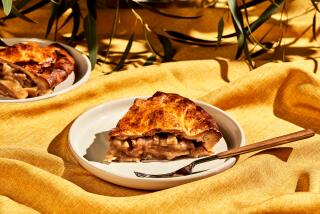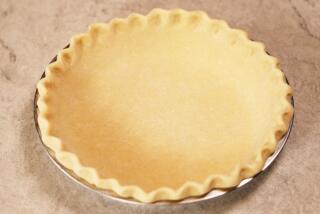How to Make Bread With an Old-Fashioned Hard Crust
- Share via
Question: How can you make bread have a hard crust like old-fashioned Italian bread?
Answer: In “Professional Baking” (John Wiley & Sons: 1985), author Wayne Gisslen explains: “The crisp, thin crusts of French, Italian and Vienna breads and of hard rolls are achieved by using formulas with little or no sugar and fat and by baking with steam. Because the crust is part of the attraction of these items, they are often made in long thin shapes that increase the proportion of crust.”
Following these guidelines, select a favorite recipe that contains very little, if any, sugar and butter, shortening or oil. To create steam during baking, position a jellyroll pan on the lowest oven rack and add -inch of boiling water just before the bread is placed in the oven.
Q: Can you tell me where to find epazote, a Mexican seasoning?
A: We uncovered two sources of this pungent herb that is used extensively in Mexican cooking, particularly in black beans: Jones Grain Mill, a health-food store in Grand Central Market, 315 S. Broadway, Los Angeles, and by mail-order from Gourmet Treasure Hunters, 10044 Adams Ave., Suite 305, Huntington Beach 92646.
Q: Once in a while a fabulous dessert mix comes on the market. One was Fudge Jumbles, which you mixed and baked like brownies. Are they gone forever?
A: We contacted Pillsbury, the company that produced Fudge Jumbles, and were told that the mix is no longer in distribution.
Q: I have looked everywhere it seems for some divided plates for fondue. The ones I am referring to have five or six small divisions in the plate to hold the different fondue dips.
A: The plates have been very difficult to find in the last couple years, but with fondue once again becoming popular, they are beginning to reappear. The Williams-Sonoma catalogue for Holiday 1987 features a set of six, plain white fondue plates, each with six divisions. Pick them up at a Williams-Sonoma store or contact their mail-order department, P.O. Box 7456, San Francisco 94120-7456.
Q: What is the secret of baking a light, tender spongecake? Lately mine have been turning out rather tough, and I cannot reason why.
A: Perhaps these directions from “The New Doubleday Cookbook” (Doubleday: 1985) by Jean Anderson and Elaine Hanna will help. “Have egg yolks at room temperature and beat until frothy; add sugar gradually and beat until very thick and the color of cream (use moderate to high mixer speed or lots of elbow grease if beating by hand). Add sifted dry ingredients a little at a time and mix well after each addition (low mixer speed). Beat egg whites (also at room temperature) to soft peaks and fold in by hand.”
In response to the Oct. 8 You Asked About . . . column about growing edible ginger root in Southern California, B. DeBus of Santa Monica writes: “You can raise edible ginger as I do--in a large pot. I leave a corm from the grocery store in a plastic bag with a slight amount of water--and when the green shoots show, I break off the pieces and plant them. Within a year, I have edible ginger roots.”
DeBus also reminded us of information we printed in a 1986 column: Ginger root stored in the freezer may be grated when frozen. The grated ginger root should be used immediately and the remaining rhizome should not be allowed to thaw or it will become soft.
Address questions on food preparation to You Asked About . . ., Food Section, The Times, Times Mirror Square, Los Angeles 90053. Personal replies cannot be given.
More to Read
Eat your way across L.A.
Get our weekly Tasting Notes newsletter for reviews, news and more.
You may occasionally receive promotional content from the Los Angeles Times.










